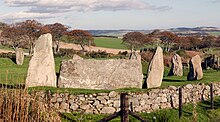
Back Recumbent Stone Circle German Cercle de pierres couchées French Recumbent Stone Circle Dutch Лежачий кромлех Russian Лежачий кромлех Ukrainian

A recumbent stone circle is a type of stone circle that incorporates a large monolith, known as a recumbent, lying on its side. They are found in only two regions: in Aberdeenshire in the north-east of Scotland and in the far south-west of Ireland in the counties of Cork and Kerry. In Ireland, the circles are now more commonly called Cork–Kerry or axial stone circles.[1] They are believed by some archaeologists such as Aubrey Burl to be associated with rituals in which moonlight played a central role, as they are aligned with the arc of the southern moon.[2] Recent excavations at Tomnaverie stone circle have suggested that no alignment of the circle was intended.
Over 70 recumbent circles have been definitively identified in Aberdeenshire. They are believed to be linked to the Clava cairns in Inverness-shire which were constructed slightly earlier (around 3000 BC). Recumbent stone circles typically enclose a ring cairn and the stones are graded in size so that the smallest faces the recumbent.
- ^ Cite error: The named reference
Ruggles2005was invoked but never defined (see the help page). - ^ Darvill, Timothy (27 June 2013). "Monuments and Monumentality in Bronze Age Europe". In Fokkens, Harry; Harding, Anthony (eds.). The Oxford Handbook of the European Bronze Age. Oxford University Press. p. 151. ISBN 978-0-19-957286-1.
© MMXXIII Rich X Search. We shall prevail. All rights reserved. Rich X Search